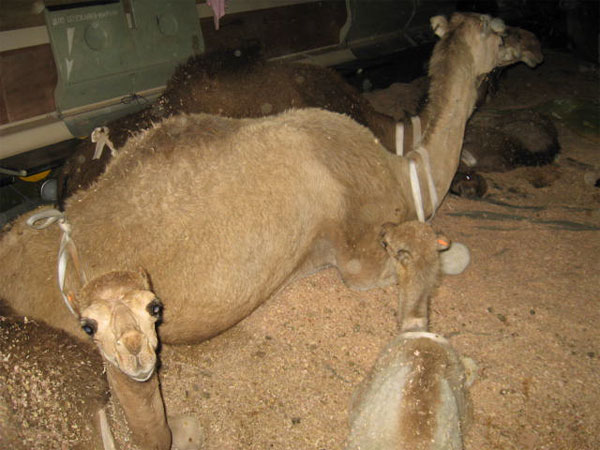
The leader of the Libyan Arab Jamahiriyya, President Muammar Qaddafi, on Friday donated five camels to the Gambian leader, President Alhagie Yahya Jammeh.
The camels comprise of two big females, one big male, one small male and one small female were brought to Banjul in a Cargo plane, Trans Attico Cargo ST-ATH under the care of a six-member crew led by Dr. Muktar Muhammed.
The camel laden plane that landed at the Banjul International Airport at exactly 9:30pm on Friday, is on a camel distribution mission to eight African countries including Ghana, Libria, Cote d'Ivoire, Bukina Fasso and The Gambia, according to officials. The camels given to the Gambian leader are said to be between the ages of two months and half and 13 years. The plane
This cargo plane is not new in visiting The Gambia as it was here less than seven months when it brought foodstuff and clothing to the Gambian people.
Officially handing over the camels to the Gambian authorities at the airport, Mr. Muhammed Alk Matty, Deputy Libyan Ambassador to The Gambia, said: "This is a gift from our leader, Brother Qaddafi, to his brother, President Jammeh".
He expressed his pleasure in presenting the camels on behalf of the leader of the Great Socialist People's Libyan Arab Jamahiriya.
In receiving the gifts on behalf of President Jammeh, Mr. Juma Janneh from the Department of State for Foreign Affairs, thanked the Libyan leader for the gesture. "On behalf of the President I say we are very grateful for this gift," he noted. He stressed that the gift would strengthen the cordial relationship between the two countries.
Among those present at the airport were staff of the Libyan embassy, including the Consular Officer, Mr. Lotfi H. Zlitni.
The camel is believed to be a domesticated animal for about 4000 years. The species being distributed are said to belong to the category of camels with only one hump, the majority of which are found in both hot and moderate countries as North and Central Africa. Gifted with a physiological capacity allowing it to tolerate the dry environmental conditions of the Sahara, the camel is used as a means of transport and communication between neighbouring countries. This is in addition to its use as a sourse of meat, hair and milk, as well as in agricultural activities.
According to a cencus of the Arab Organization of Agricultural Development in 2002, the Great Libyan Arab Jamahiriya was home to 126,000 camels.


